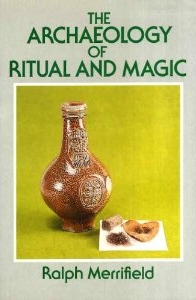 The first edition cover of the book, depicting a 17th-century bellarmine witch-bottle found in an old mill-stream, Great College Street, London | |
| Author | Ralph Merrifield |
|---|---|
| Language | English |
| Subject | Archaeology Magic |
| Publisher | B.T. Batsford |
Publication date | 1987 |
| Publication place | United Kingdom |
| Media type | Print (hardback & paperback) |
| Pages | 224 |
| ISBN | 0-7134-4870-9 |
The Archaeology of Ritual and Magic is an archaeological study of the material evidence for ritual and magical practices in Europe, containing a particular emphasis on London and South East England. It was written by the English archaeologist Ralph Merrifield, the former deputy director of the Museum of London, and first published by B.T. Batsford in 1987.
Merrifield opens The Archaeology of Ritual and Magic by discussing how archaeologists have understood magic and ritual practices in past societies, opining that on the whole it had been a neglected area of study. Looking at the archaeological evidence for ritual activity in the pre-Roman Iron Age and the Roman Iron Age of Britain, he discusses animal and human sacrifice, as well as the offering of votive deposits in rivers and other bodies of water. He moves on to explore the rituals surrounding death and burial, suggesting areas where this ritual activity is visible in the burial record of multiple societies. Merrifield goes on to discuss the archaeological evidence for ritual practices in Christian Europe, highlighting areas of ritual continuance from earlier pagan periods, in particular the deposition of metal goods in water. Looking at the evidence for foundation deposits in European buildings that likely had magico-religious purposes, he then looks at several examples of written charms and spells which have survived in the archaeological record.
Upon publication, The Archaeology of Ritual and Magic received predominantly positive reviews in academic peer-reviewed journals such as Folklore and The Antiquaries Journal. In the ensuing years, the book has been widely cited by scholars as an influential and pioneering text in the study of the archaeology of ritual and magic.